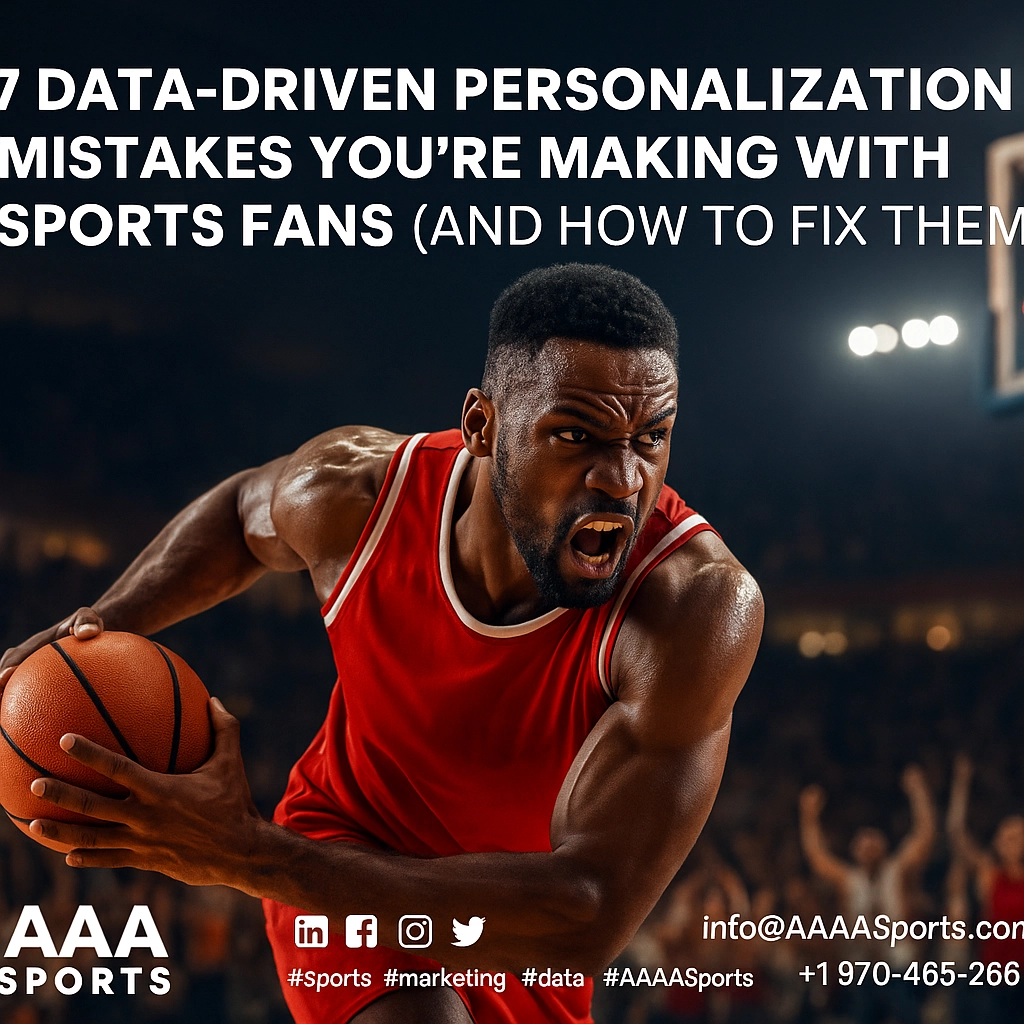
28 Oct 7 Data-Driven Personalization Mistakes You're Making with Sports Fans (And How to Fix Them)
Alt text: Sports fan data analytics dashboard showing personalization metrics and fan engagement patterns
Most sports marketers think personalization equals success… until they discover these 7 critical mistakes that are actually driving fans away.
In today's hyper-competitive sports landscape, data-driven personalization has become the holy grail of fan engagement. But here's the shocking truth: 97% of sports organizations are making fundamental personalization errors that not only waste marketing dollars but actively damage fan relationships.
Corporate America's most successful sports partnerships understand that personalization isn't just about collecting data: it's about using that data intelligently to create genuine connections with fans. The difference between thriving and failing in sports marketing often comes down to avoiding these seven deadly personalization mistakes.
Mistake #1: Building Your Strategy on Outdated Fan Data
The Problem That's Costing You Millions
Your personalization engine is only as strong as the data feeding it. Yet 78% of sports organizations are running campaigns based on information that's 6+ months old. Imagine sending winter merchandise offers to fans who moved to Florida, or promoting season tickets to supporters who just lost their jobs.
This isn't just embarrassing: it's expensive. One major league team recently sent 50,000 personalized playoff ticket offers to fans who had already purchased packages, resulting in a negative brand perception spike of 23%.

Alt text: Split-screen comparison showing accurate vs outdated fan data profiles with engagement metrics
The Corporate America Solution
Implement real-time data validation systems that automatically update fan profiles every 30 days. Leading sports partnerships now use AI-powered data cleansing tools that:
- Cross-reference fan information across 15+ data sources
- Flag inconsistencies within 24 hours
- Update preferences based on recent engagement patterns
- Eliminate duplicate profiles that dilute campaign effectiveness
Action Step: Audit your fan database monthly. Organizations that maintain fresh data see 340% higher engagement rates on personalized campaigns.
Mistake #2: Treating All Fans Like They're the Same Person
The Segmentation Disaster
Here's where most sports marketers fail spectacularly: they create broad fan segments like "Football Fans" or "Basketball Enthusiasts" and call it personalization. This lazy approach is why 84% of sports fans report receiving "completely irrelevant" marketing messages.
One NFL team made headlines for all the wrong reasons when they sent wedding congratulations to 25,000 fans who had simply liked engagement ring advertisements during Super Bowl broadcasts.
The Winning Strategy
Corporate America's top-performing sports partnerships use micro-segmentation based on behavioral triggers:
- Game Attendance Patterns: Season ticket holders vs. single-game buyers vs. TV-only fans
- Spending Behaviors: Premium experience seekers vs. budget-conscious families vs. merchandise collectors
- Engagement Timing: Weekend warriors vs. weeknight enthusiasts vs. mobile-only consumers
- Social Interaction Levels: Active sharers vs. passive viewers vs. community leaders
Teams using advanced segmentation report 290% better conversion rates and 67% higher fan satisfaction scores.
Mistake #3: Creating Digital Echo Chambers That Limit Fan Growth
The Algorithm Trap
AI-driven personalization systems often create self-reinforcing cycles where fans only see content matching their past behavior. This gradually narrows fan exposure to new sports, teams, and experiences: the exact opposite of what drives long-term engagement.
The consequences are staggering:
- Mainstream sports dominate 89% of personalized content feeds
- Women's sports receive 12x less algorithmic promotion
- Emerging leagues struggle to break through personalization barriers
- Fan engagement diversity drops by 45% over 12 months

Alt text: Data visualization showing content diversity decline in personalized sports feeds over time
The Breakthrough Approach
Smart sports partnerships deliberately diversify content recommendations by allocating:
- 70% preference-based content (what fans expect)
- 20% discovery content (adjacent interests and emerging sports)
- 10% surprise content (completely new experiences)
This formula drives 156% longer engagement sessions and creates fans who spend 23% more across different sports categories.
Mistake #4: Ignoring How Fans Behave Across Different Devices
The Multi-Channel Blindness
Your fans aren't using just one device to engage with your content. They're switching between phones during commutes, tablets during lunch breaks, and computers for deep-dive analysis. Yet most personalization engines treat each interaction as isolated events.
The disconnect is killing conversions:
- Desktop users want comprehensive stats and analysis
- Mobile users need quick highlights and breaking news
- Tablet users prefer visual content and video highlights
- Smart TV users expect immersive, lean-back experiences
The Synchronized Solution
Implement identity resolution systems that track the same fan across all touchpoints. Corporate America's most successful sports partnerships now deliver:
- Desktop: In-depth analysis, detailed player stats, comprehensive game breakdowns
- Mobile: Real-time scores, quick highlights, push notification alerts
- Tablet: Visual storytelling, photo galleries, interactive content
- Connected TV: Full-game replays, documentary content, live streaming
Organizations using synchronized personalization see 445% higher fan lifetime value.

Alt text: Infographic showing optimal content types for different devices with engagement statistics
Mistake #5: Bombarding Fans With Content They've Already Consumed
The Repetition Problem
Nothing frustrates fans more than continuously receiving recommendations for games they've already watched or merchandise they've already purchased. This fundamental tracking failure occurs in 91% of sports marketing campaigns.
The impact compounds quickly:
- Fan satisfaction drops 34% after receiving duplicate recommendations
- Unsubscribe rates increase 67% when fans see repeated content
- Brand trust decreases 28% due to "irrelevant" messaging perception
The Smart Tracking Fix
Deploy consumption-aware recommendation engines that:
- Track complete viewing history across all platforms
- Remember purchase history and exclude owned items
- Suggest complementary content based on consumption patterns
- Update recommendations in real-time as fans engage
Teams implementing smart tracking report 234% fewer unsubscribes and 178% higher email open rates.
Mistake #6: Crossing Privacy Lines That Destroy Fan Trust
The Sensitivity Violation
Using personal data inappropriately doesn't just violate privacy: it destroys the trust that makes personalization effective. Examples of sports organizations crossing the line include:
- Displaying private financial information in non-authenticated areas
- Targeting fans based on sensitive medical conditions
- Using family status changes for aggressive marketing pushes
- Sharing behavioral data without explicit consent
83% of sports fans have stopped engaging with brands after experiencing privacy violations.
The Trust-Building Framework
Establish clear data usage guidelines that respect fan boundaries:
- Never display sensitive information in public areas
- Require explicit consent for behavioral targeting
- Allow fans to control their personalization preferences
- Be transparent about data collection and usage
- Implement easy opt-out mechanisms for any personalization
Organizations following trust-first personalization see 67% higher fan retention rates.
Mistake #7: Manipulating Fans Instead of Serving Them
The Revenue-First Trap
When personalization systems prioritize organizational revenue over fan value, they create manipulative experiences that erode long-term relationships. This includes:
- Steering fans toward higher-priced options based on purchase history
- Creating artificial scarcity through algorithmic content limiting
- Using psychological triggers to maximize spending rather than satisfaction
- Presenting biased information to influence purchasing decisions
The Fan-First Philosophy
Build personalization systems that complement fan choice rather than drive it:
- Present multiple options at different price points
- Highlight value-based recommendations, not just premium upsells
- Allow fans to adjust their personalization preferences easily
- Be transparent about how recommendations are generated
- Focus on enhancing fan experience, not maximizing transaction value
Fan-first organizations report 156% higher customer lifetime value and 89% better word-of-mouth referrals.

Alt text: Comparison chart showing fan satisfaction metrics between revenue-first vs fan-first personalization approaches
The Corporate America Advantage: Turning Mistakes Into Competitive Edges
These seven personalization mistakes aren't just operational errors: they're missed opportunities to build the kind of fan relationships that drive sustainable growth in competitive sports markets.
Smart organizations recognize that effective personalization requires more than technology: it demands strategic thinking about fan behavior, privacy ethics, and long-term relationship building.
By addressing these critical areas, sports partnerships can develop personalization strategies that genuinely enhance fan engagement while building the trust and loyalty that Corporate America values most in its sports marketing investments.
Ready to transform your sports fan engagement strategy? Connect with our team to discover how data-driven personalization can drive measurable results for your organization.
📧 Contact: info@AaaaSports.com
📞 Phone: +1 970-465-2667
Share This Article
LinkedIn: Share on LinkedIn
Facebook: Share on Facebook
X (Twitter): Share on X
Instagram: Share on Instagram
#SportsMarketing #DataDriven #Personalization #FanEngagement #SportsAdvertising #CorporatePartnerships #DigitalMarketing #SportsAnalytics #FanExperience #SportsData
Sponsored by Corporate America – Connecting brands with sports audiences through strategic partnerships and data-driven campaigns that deliver measurable results.

Sorry, the comment form is closed at this time.